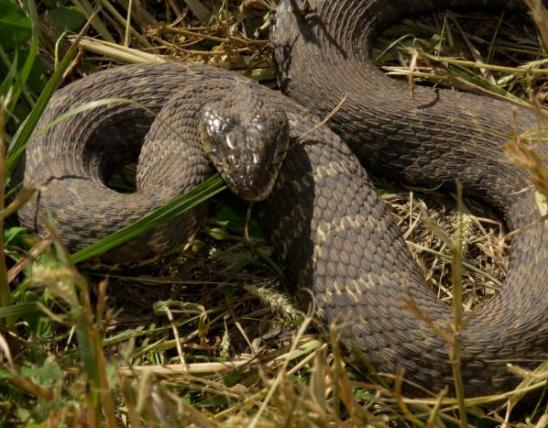
The bullsnake is Missouri's largest native snake. It is tan, yellow, cream-colored, or white with about 40 large brown or black blotches along the back. The markings along the back and sides are generally black on the neck and tail; at midbody they are brown. The tail may have light and dark bands. There is usually a black line from the eye down to the jaw, and black bars along the upper lip. The belly is yellow or cream-colored, with a checkering of square or rectangular black or dark spots.
If approached or cornered, a bullsnake will coil, vibrate its tail, and hiss loudly with the mouth partly open. If captured, it will bite to defend itself, but some individuals will calm down quickly and can be handled with ease.
Similar species: The bullsnake's closest relatives are the its sister subspecies, none of which occur in Missouri, but they may be familiar to you if you've been to states to our west and southwest and to Mexico; most of these subspecies are called gopher snakes.
Adult length: usually 37 to 72 inches; they have been known to reach 105 inches (8 feet 9 inches) in length.

Statewide, except for the southeastern quarter of the state. Most common along the western grassland areas of the state, with scattered locations throughout the Ozarks and northern Missouri.
Habitat and Conservation
A species of native tallgrass prairies, other grasslands, and savannas; also occurs in pastures and old fields as well as along some river bluffs. Most commonly seen in native prairies in southwestern Missouri.
In Missouri, bullsnakes may be active from late March to the middle of November. Most bullsnakes are seen in May and June. They bask in the sun or search for food by day; at night they take shelter in mammal burrows, in clumps of vegetation, in rock piles, or under objects. They may also climb into shrubs and trees. The head shape facilitates burrowing into loose soil.
Bullsnakes overwinter in the burrows of small mammals, under rock piles, or in rock crevices on rocky hillsides.
Food
Bullsnakes consume small mammals, especially rodents, which is why they are considered beneficial to agriculture. This species is extremely valuable in controlling destructive rodents. Known foods include mice, rats, ground squirrels, pocket gophers, small rabbits, birds, and bird eggs. Bullsnakes kill larger prey by constriction, but small prey are simply grasped by the mouth and swallowed.
Status
A species of conservation concern in Missouri. Habitat loss, and deaths caused by automobiles and agricultural machinery, threaten this species in Missouri.
Easily considered a beneficial species because of the large number of destructive rodents it eats. One of the most economically beneficial snakes in Missouri; a boon to agriculture.
Life Cycle
Courtship and mating occur in April and May. Eggs are laid during June or July, with 4–21 eggs per clutch. Female bullsnakes deposit their eggs in sandy or loose soil, in nests excavated by the female in loose soil, or in abandoned small mammal burrows, or under large rocks, stumps, or logs. Hatching usually occurs in late August through September.
Female bullsnakes do not reproduce every year. Males apparently become sexually mature within their first two years of life, while females usually only mature after their third year. Lifespan can generally be 20 years or more; one bullsnake, in captivity, lived for more than 33 years.
Human Connections
Because of the large number of crop-destroying rodents it eats, this species is a valuable neighbor to farmers. It is the most economically beneficial snake species in Missouri, and rural Missourians should make every effort to protect it.
Humans have caused the factors that endanger this snake: conversion of native prairie to cropland is a principal reason for loss of habitat for this and other prairie-dependent species. Many bullsnakes are also killed by agricultural machinery during haying and by cars on roads.
Ecosystem Connections
Bullsnakes rely on small mammals for food but many also take advantage of small mammal burrows for shelter and places to lay eggs.
As with many other predatory species, bullsnakes can be preyed upon themselves by larger mammals and by birds; this explains their defensive hissing and biting. The eggs and young are especially vulnerable, and many individuals perish well before adulthood.































